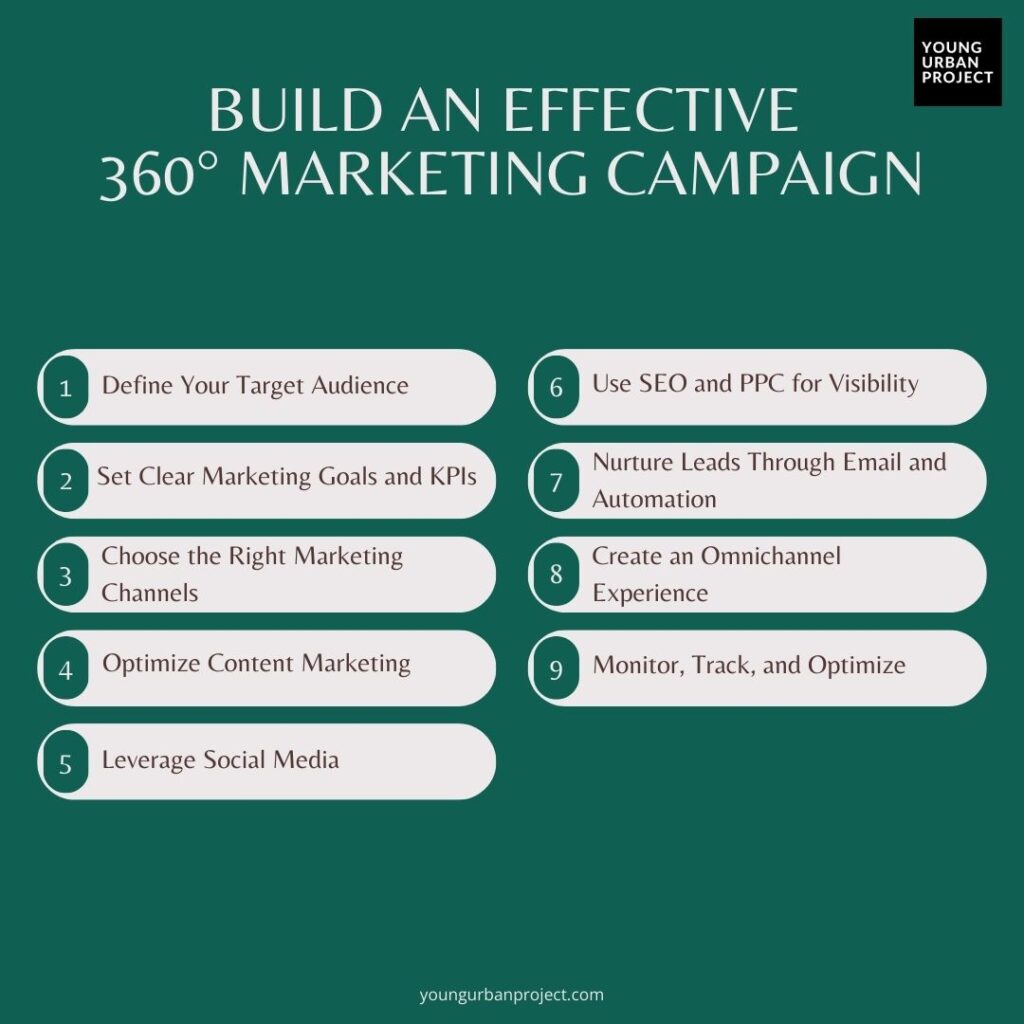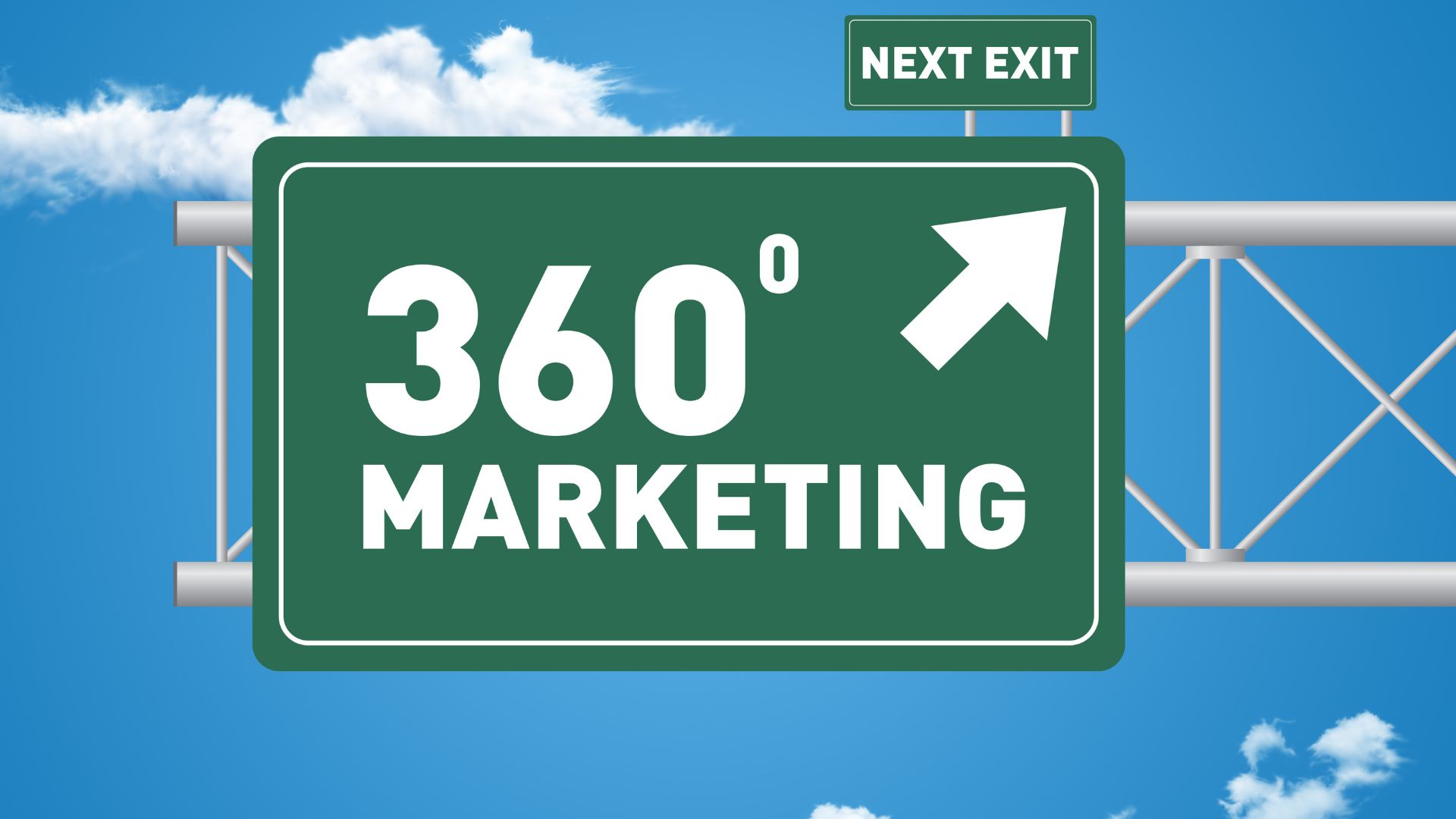Ever feel like your marketing efforts are scattered shots instead of a cohesive strategy? That’s where 360 degree marketing comes in. In 2025, brands can’t afford to focus on just one or two channels—customers expect a seamless experience everywhere they interact with you. This approach isn’t just a buzzword; it’s about making sure your messaging stays consistent whether someone finds you through a Google search, Instagram ad, or billboard downtown. By connecting these dots, you’re not just marketing more efficiently—you’re building recognition that sticks and turns more browsers into buyers.
Table of Contents
What is 360 Degree Marketing?
Simply put, 360-degree marketing means surrounding your customers with your brand message wherever they might encounter it. It’s about breaking down the walls between your digital and traditional marketing efforts.
It includes:
- Blending online and offline channels that work together
- Putting yourself in your customer’s shoes at every step
- Making sure your look and message stay consistent
- Using real data to guide your decisions, not just hunches
This approach combines everything from your social media and email campaigns to good old-fashioned print ads and events. The goal? Creating multiple touchpoints that reinforce each other and make your brand impossible to forget.
Why is 360 Degree Marketing Important?
1. Consistency across channels
Consistency across channels builds stronger brand recognition. When customers see the same message and visual identity on social media, your website, and in-store displays, they’re more likely to remember and trust your brand. This repetition cuts through the noise of competing messages that bombard consumers daily.
2. Maximizing customer touchpoints
Maximizing customer touchpoints helps you stay connected throughout their buying journey. From the moment they first hear about your product to after-purchase support, each interaction reinforces your relationship. This ongoing presence keeps your brand top-of-mind when they’re ready to buy.
3. Improved ROI
This comes naturally with a well-connected marketing approach. Instead of wasting money on disconnected campaigns, your efforts support each other. A TV ad drives website visits, email campaigns remind past customers about new products, and social media reinforces both—all working together to boost conversion rates.
4. Better audience segmentation
Better audience segmentation lets you speak directly to different customer groups. By collecting data across channels, you’ll understand exactly who your customers are and what they want. This means you can craft messages that feel personal rather than generic, making customers feel understood.
How AI is Changing 360 Degree Marketing in 2025
1. Smarter Customer Targeting
AI tools now help businesses find exactly who needs their products by looking at what people do online. Small companies can now reach perfect customers just like big brands do. Instead of guessing who might buy, AI shows you the exact people who are already looking for what you sell, saving both time and money.
2. Personalized Customer Experiences
AI creates different messages for different customers based on their past purchases and online behavior. When someone visits your website, they see products they’ll actually want. Your emails mention things they care about, not generic offers. This personal touch makes people feel understood rather than just marketed to.
3. Automated Content Creation
Marketing teams use AI to help write blog posts, create social media updates, and design basic ads much faster than before. This lets even small teams put out fresh content across many channels without hiring extra help. Businesses can now maintain active presences everywhere their customers spend time.
4. Real-Time Campaign Adjustments
AI watches how marketing campaigns perform and makes changes immediately when something isn’t working. If Facebook ads aren’t getting clicks but Instagram stories are, AI moves budget there automatically. This constant optimization means less wasted money and better results without needing marketing experts to analyze everything.
5. Predictive Customer Insights
AI spots patterns in customer behavior that humans would miss and predicts what people might want next. Businesses can now prepare promotions for products customers are likely to need before they even search for them. This helps companies stay one step ahead of customer needs instead of just reacting.
How to Build an Effective 360° Marketing Campaign?
Creating a 360° marketing strategy isn’t just about being everywhere—it’s about being everywhere with purpose. Each piece should fit together like a puzzle, creating a complete picture for your customers. Here’s how to build one that works:

1. Define Your Target Audience & Buyer Personas
Know exactly who you’re talking to before saying a word. Dig into the real problems your customers face and how they make decisions. What keeps them up at night? Where do they hang out online?
Use tools like:
- Customer surveys and interviews
- Social media marketing analytics
- Purchase history data
- Website behavior tracking
The deeper you understand your audience, the more effective every dollar you spend will be.
2. Set Clear Marketing Goals & KPIs
Without clear goals, you’ll never know if you’re winning. Decide what success looks like before you start—whether that’s brand awareness, sales numbers, or customer loyalty.
Your goals might include:
- Increasing website traffic by 30%
- Boosting conversion rates from 2% to 3%
- Growing email list subscribers by 1,000
- Improving customer retention by 15%
Match each goal with specific numbers you can track, then check them regularly to stay on course.
Also Read: 20 Digital Marketing KPIs to Track Success in 2025
3. Choose the Right Marketing Channels
Not every marketing channel works for every business. Pick the ones where your specific customers actually spend time.
Focus on a mix of:
- Owned media you control (your website, blog, email list)
- Paid media you purchase (Google ads, sponsored posts, TV commercials)
- Earned media others create (reviews, social shares, press coverage)
Start with 3-5 key channels that work together instead of trying to be everywhere at once. Quality beats quantity every time.
4. Optimize Content Marketing for Maximum Engagement
Effective content marketing goes far beyond simply improving SEO; it’s about delivering genuine value by addressing the real questions and needs of your customers. Create material that resonates with your audience, encouraging them to read, watch, or listen.
Focus on making:
- Blog posts that solve specific problems
- Videos that explain complex ideas simply
- Infographics that make data digestible
- Case studies showing real results
Remember, helpful content gets shared, builds trust, and keeps people coming back for more.
5. Leverage Social Media for Engagement & Brand Building
Social media works best when you stop selling and start connecting. Build relationships first, then sales will follow naturally.
Pick platforms where your audience actually hangs out—don’t waste time elsewhere. Instagram might be perfect for fashion brands but useless for industrial equipment. Partner with people your audience already trusts instead of always pushing your message directly.
Enroll Now: Live Advanced Digital Marketing Course
6. Search Engine Optimization (SEO) & Paid Advertising (PPC)
SEO gets you free traffic, but takes time. Pay-per-click or PPC costs money but works immediately. You need both.
For SEO, focus on:
- Using keywords your customers actually search for
- Creating genuinely helpful content
- Building quality backlinks from trusted sites
For PPC:
- Target specific customer actions and interests
- Test different headlines and images
- Start small, then scale what works
Also Read: The Difference Between On-Page and Off-Page SEO
7. Nurture Leads Through Email & Marketing Automation
Email remains one of the highest-ROI channels because it reaches people who already know you. Don’t waste this direct line to your customers.
Set up automated sequences for:
- Welcome emails for new subscribers
- Abandoned cart reminders
- Product recommendations based on past purchases
- Re-engagement campaigns for inactive customers
Personalize messages when possible—people respond to emails that feel written just for them.
Read More: Top AI Email Writers: Generate High-Impact Emails
8. Creating a Seamless Omni-Channel Experience
Customers shouldn’t feel like they’re dealing with different companies when they switch from your app to your store to your website. Make transitions smooth.
Ensure your:
- Visual identity stays consistent everywhere
- Customer data follows them across channels
- Messaging feels connected, not contradictory
- In-store and online experiences complement each other
The gold standard is when customers can start shopping on mobile and finish on desktop without missing a beat.
9. Monitor, Track, and Optimize the Campaign
Numbers tell you the truth about what’s working. Check them regularly, but don’t get lost in data overload.
Focus on tracking:
- Which channels drive actual sales, not just traffic
- How customers move between touchpoints
- Which content gets engagement and which doesn’t
- Where customers drop off before purchasing
Then make real changes based on what you learn—kill what’s not working and double down on what is.
Top Challenges in 360 Degree Marketing & Solutions
1. Managing Multiple Channels Efficiently
Juggling social media, email, ads, and website content can feel overwhelming. Most marketers end up spending too much time on busy work instead of strategy.
Solution: Use basic tools like Hootsuite or Buffer to schedule posts across platforms. Start with simple automations for common tasks like welcome emails or social media posting. You don’t need fancy AI—even basic scheduling tools can save hours each week.
2. Keeping Up with Rapidly Changing Technology
Just when you master Facebook ads, TikTok takes over. And now everyone’s talking about AR filters and AI chatbots.
Solution: Don’t chase every shiny new tool. Pick one or two new technologies that directly help your specific customers. Test them on a small scale first. Sometimes a well-executed email campaign still beats the newest tech. Focus on what your customers actually use, not what’s trendy.
3. Reaching the Right Audience Amid Increasing Competition
Everyone’s fighting for attention, and ad costs keep rising. Getting noticed is harder than ever.
Solution: Stop trying to reach everyone. Talk directly to smaller, specific groups with messages made just for them. A targeted campaign to 100 perfect customers beats a generic one to 10,000 random people. Use customer purchase history and website behavior to create messages that feel personal.
4. Measuring ROI & Proving Marketing Effectiveness
Figuring out which parts of your marketing actually drive sales can feel impossible. Did they buy because of your email or Instagram ad?
Solution: Start tracking the basics with free tools like Google Analytics. Set up simple UTM tags on your links to see where traffic comes from. Focus on a few key numbers that connect directly to revenue, not vanity metrics like followers. Even basic tracking beats guesswork.
Also Read: What Is Digital Marketing ROI
5. Budget Constraints & Resource Allocation
Most businesses can’t afford to be everywhere at once. Limited money means hard choices.
Solution: Start by putting most of your budget in the 2-3 channels that already work best for you. Cut anything that doesn’t show clear returns. Test new channels with small amounts before going all-in. Adjust your spending monthly based on real results, not annual plans. Sometimes doing fewer things better beats doing everything poorly.
Conclusion
Let’s face it, customers in 2025 are bombarded with messages from all sides. The businesses winning their attention aren’t shouting louder – they’re showing up consistently in all the right places. 360 degree marketing isn’t fancy rocket science; it’s about making sure your customer sees the same story whether they’re scrolling Instagram, checking email, or walking past your store.
You don’t need a massive budget or complicated tech to make this work. Start by deeply understanding who your customers really are, focus on a few channels they actually use, and track what brings in real sales. The gap between companies growing and those falling behind in 2025 isn’t about who spends more, it’s about who connects their marketing dots better.
FAQs: 360 Degree Marketing
1. What is the main purpose of 360 degree marketing?
To create a consistent brand experience across all touchpoints where customers might interact with your business. It helps build stronger recognition and trust by reinforcing your message through multiple channels.
2. How do I create a successful 360 degree marketing campaign?
Start by knowing exactly who your customers are and what they need. Then pick a few key channels where they spend time, create consistent messaging across those channels, and track results to see what’s working.
3. What are the most effective channels for a 360 degree marketing strategy?
There’s no one-size-fits-all answer – it depends on your specific customers. For most businesses, a mix of website, email, social media, and some offline touchpoints works well. Pick channels where your customers actually spend time.
4. How do I measure the success of my 360 degree marketing efforts?
Track key numbers that connect to your business goals – like website traffic, conversion rates, cost per customer, and total sales. Use basic tools like Google Analytics and UTM codes to see which channels drive actual results.
5. How does 360-degree marketing differ from omnichannel marketing?
They’re similar, but 360-degree marketing focuses on surrounding customers with consistent messaging across all possible touchpoints. Omnichannel specifically emphasizes creating seamless customer experiences as people move between channels.

